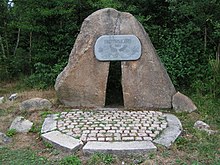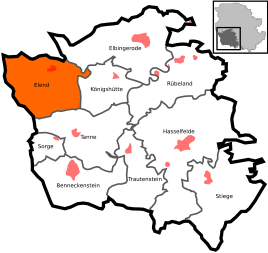Misery (Harz)
|
misery
City of Oberharz am Brocken
|
|
|---|---|
| Coordinates: 51 ° 44 ′ 41 ″ N , 10 ° 41 ′ 10 ″ E | |
| Height : | 490 (480-525) m |
| Area : | 27.39 km² |
| Residents : | 429 (Dec. 31, 2008) |
| Population density : | 16 inhabitants / km² |
| Incorporation : | January 1, 2010 |
| Postal code : | 38875 |
| Area code : | 039455 |
|
Location of misery in Oberharz am Brocken
|
|
|
Look at misery
|
|
Elend is a district of the town of Oberharz am Brocken in the Harz district in Saxony-Anhalt .
Geographical location
Elend is located in the Harz (Hochharz) in the Harz / Saxony-Anhalt Nature Park just outside the Harz National Park . It is located south of the Hohnekamm with the strawberry head , southeast of the Barenberg and north-northwest of the Rauhen Jakob at about 480 to 525 m above sea level. NN in the valley of the Kalten Bode , which is called north of the village of Elendstal and is designated as a nature reserve. There is also the spruce valley guard , which is part of a natural monument. About 3 km west of the village is the Kramershai nature reserve and parts of the Harzer Bachtäler nature reserve extend to the south . The north-north-west neighboring village is Schierke .
Local division
In addition to the main town, the Mandelholz and Wietfeld residential areas are also part of Elend.
climate
The annual precipitation is 1116 mm and is therefore in the upper third of the values recorded by the measuring points of the German Weather Service . Over 90% indicate lower values. The driest month is September; it rains most in December. In the wettest month there is around 2.1 times more rain than in the driest month. The seasonal fluctuations in precipitation are in the upper third. In over 91% of all places, the monthly precipitation fluctuates less.
Economy and Infrastructure
economy
There are several places to stay overnight.
traffic
The place is on the B 27.
history



The field name under the misery path is mentioned for the first time in 1483. In a bailiff's account of the Elbingerode (Harz) office from 1506/07, the following is recorded under revenue: Innome von der Sagemoln zum Elende deß Forst XII Mar [k] . There is much evidence that this sawmill existed some time before.
It was not only the construction of an ironworks in the late 18th century that gave rise to the small settlement of Elend. Hauß and Hof auf dem Elende in Hartze existed as early as 1619 and were owned by Statius von Münchhausen, the Elbingerode holder. He sold the house and the courtyard and the Wiesenplatz next to it for 200 thalers to his loyal servant Sander Bräutigam von der Erichsburg . This groom is later referred to as a forester. He was allowed to keep cows and cattle here, brew beer and serve it to passers-by. In addition to this forester's house, which was also used as a dairy and was so called, the sawmill must have continued to exist. In 1731 this was fundamentally repaired because the Ehlendsche Sagemühle had to be kept in good condition because of the blocs destined to St. Andreasberge every year .
In the course of the 18th century, information about repairs to this sawmill can be found again and again. In 1763, the forester's house Elend changed from the Theuerkauf family, who were the descendants of the groom, into the possession of the forester Johann Dietrich Führer, who sold his house and its accessories to the state of Hanover between November 1787 and February 1788. In the course of 1781 the construction of a new iron and steel works in Elend began, which was built not far from the previous forester's house.
The first school was built in 1796. In 1818 the furnace was demolished again, and in 1863 the ironworks was shut down completely, making the ironworkers unemployed and the population falling rapidly. Their only source of income was then forestry.
The church was built before 1897, and in 1924 the central war memorial to Elend .
After the First World War , a new branch of the economy was added with tourism. In 1925 there were already 31,550 overnight stays in the summer. The Harzquerbahn had been running since 1899 , and in 1928 a road to Schierke and Wernigerode was built (Feuersteinstraße) . In 1933 a forest pool was opened.
In the cemetery there is a war cemetery for a large number of German soldiers who died in April 1945. From 1945 to 1948 Heinrich Clausen was mayor of the town.
Until 1990, misery lay right on the inner-German border . Several times, misery resulted in fatal escape attempts. In 1964 Peter Müller and in 1966 Klaus Schaper died near the village. Jürgen Hainz tried to flee in 1971. He was shot and died in a hospital in 1972. The Magdeburg district administration of the Ministry for State Security ( MfS ) maintained a rest home for full-time employees and their families in Elend. On November 12, 1989 the border in Elend was opened, the border monument Elend commemorates this.
On January 1, 2010, the municipality of Elend merged with the municipalities of Sorge , Stiege and Tanne and the cities of Elbingerode (Harz) , Hasselfelde and Benneckenstein (Harz) to form the town of Oberharz am Brocken.
Development of the population:
- 1800: 150
- 1890: 1897
- 2003: 632 (June 30)
badges and flags
Blazon : "In red a silver tip topped with a fir tree growing from a green arched shield base."
The municipality of Elend has a coat of arms according to its main statute (Section 2, Paragraph 1). The Magdeburg municipal heraldist Jörg Mantzsch designed it according to an earlier official seal and introduced it into the approval process in 1996.
According to the statutes, the flag of the former municipality is green and white, covered with the coat of arms.
Personalities
- Friedrich Krebs (1832–1905), first Chief Apostle of the New Apostolic Church
- Hartmut Esser (* 1943), sociologist, professor at the University of Mannheim
District Administrator Friedrich Boehm died in the village in 1906. In 1922, the poacher Wilhelm Mückenheim was shot in the district of Elends . The poacher's stone reminds of him. In 1943, the writer Wolfgang Borchert spent a long time in a hospital in misery. The multiple GDR champion in cross-country skiing and Olympic participant Karsten Brandt (* 1958) spent his childhood in misery.
literature
In 1777 Goethe stayed in misery to write his treatises on granite . He was impressed with the area so that he in the Walpurgis Night scene of his Faust I earned.
Wilhelm Raabe let his story Else von der Tanne play in misery at the time of the Thirty Years War .
Culture
In Elend there are major events several times a year: the Upper Harz New Year's Eve fun , the traditional skijoring , the Rocken am Brocken Festival and the Waldbad and Schützenfest.
literature
- Karlheinz Brumme: Misery. Chronicle of a Harz village under the Brocken . Blankenburg, Wernigerode, undated [2008]
- Dietmar Schultke: Everyday life in the GDR in the border company Elend . In: Nobody gets through - The history of the inner-German border and the Berlin Wall . Aufbau-Verlag Berlin, 4th edition 2008.
Web links
Individual evidence
- ↑ Landesarchiv Sachsen-Anhalt , H 9-1, 33 Fach 1–5 Nr. 2, Bl. 12r






